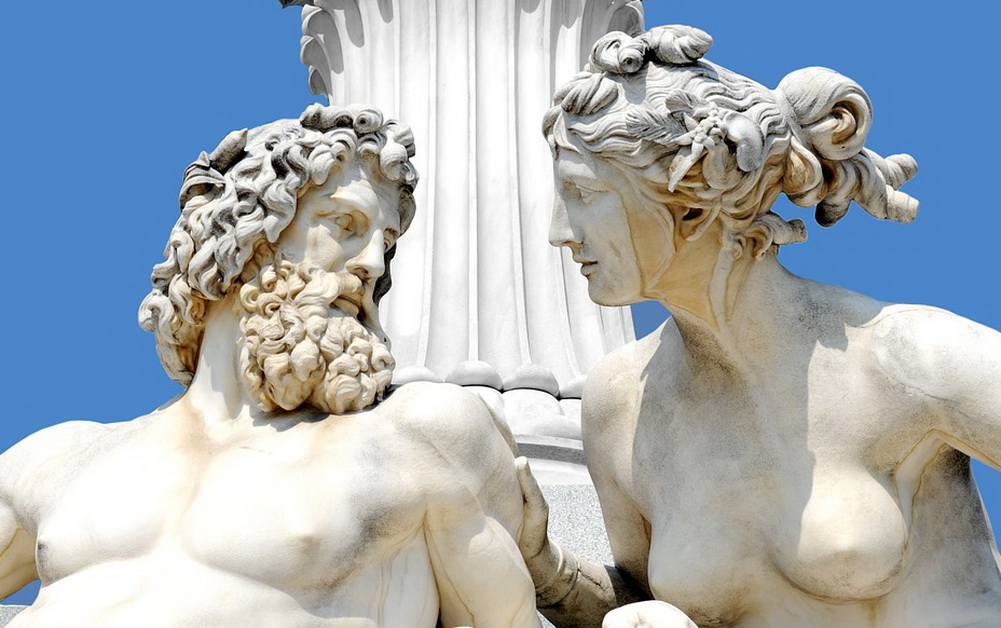Zeus (Greek Mythology)
The Greek god Zeus was the sixt and last child of Cronus and Rhea. Cronus would swallow his own newborns because he feared that children would overthrow him as he did unto his father Uranus. In an effort to save her last child Zeus, Rhea gave birth in a cave and made her husband swallow a stone instead of Zeus.
Amalthea
Zeus was raised by a goat named Amalthea. Another rumor has it that Amalthea was in fact a nymph and she took the newborn Zeus to a cave on Mount Ida (Kazdağı) in western Anadolia and raised him with goat’s milk. Again, fate played its part and when Zues became an adult, he overthrew his father and preempted the throne. He saved his siblings, whom his father had swallowed earlier, by making his father drink a potion given by metis the goddess of wisdom. Thus Zeus began to rule in Olympus together with his siblings.
Powers of Zeus
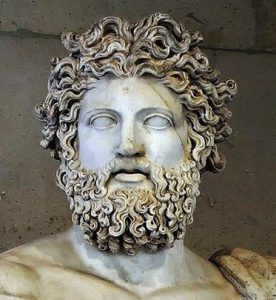
Zeus was the top Olympian god in the Greek pantheon and he combined all naturall Powers in himself related to the sky. Light, clouds, thunder, lightning; they were all embodied in Zeus. He is characterized in the Iliad as the one who collects clouds, who creates thunder and casts thunderbolds. In the story of the Trojan War, Zeus, as a judge, listens to the claims of other gods in support of their side. He then renders decisions on acceptable behavior. He remains neutral most of the time, allowing his son Sarpedon to die and glorifying his favorite, Hector. It is this thundering god who establised the dominion of gods fort he first time, after Uranus and Cronus. The eagle was his sign of dominion to the eyes of people. On some occasions, he would display boundless tolerance for his wife Hera and on different occasions, he would confront her directly and disappoint her in her attemps.
Zeus Roman Equivalent
The Latin name for Zeus is Jupiter and sometimes Jove. The root of both “Zeus” and “Jupiter” is in a proto-Indo-European word for the often personified concepts of “day/light/sky”. Jupiyter is thought to be made up of a Proto-Indoeuropean word for god, *deiw-os, combined with the word for father, pater, like Zeus + Pater.
Family
Zeus was the husband of Hera, but he had many affairs with other goddesses, mortal women, and female animals. Zeus mated with, among others, Aegina, Alcmena, Calliope, Cassiopea, Demeter, Dione, Europa, Io, Leda, Leto, Mnemosyne, Niobe, and Semele.
Zeus’s Wifes
Metis
Zeus married seven times according to Hesiod. First he married Metis, the Titan goddess of wisdom and this marriage produced Athena. Because it was prophesied that the children to be born from Metis during her labor and Athena was born from teh head of her father, not from her mother.
Themis
His second marriage was to goddess Themis who symbolized justice. From this marriage came forth the Horae were named Eunomia, representing discipline, Dike, representing justice, and Eirene, representing peace. Also born were the Moirae who were goddesses of fate.
Dione
Zeus’s third wife was Dione of the Titans. From her came forth Aphrodite (There are also ather versions of the birth of Aphrodite.) Oceanus and Tethys begat around three thousand daughters, an done of these was Eurynome. Zeus entered into his fourth marriage to her. In his Theogony, Hesiod tells of this marriage as follows.
“And Eurynome, the daughter of Ocean, beautiful in form, bare him three fair-cheeked Charites (Graces), Aglaea and Euphrosyne and lovely Thaleia.”
Mnemosyne
Zeus fifth wife was Mnemosyne. The Muses, fairies of art, were born from this marriage. His sixth marriage was to Leto. As is known, Apollo and Artemis were born from this marriage.
Demeter
Demeter was the seventh wife of Zeus. Persephone was born from this marriage.
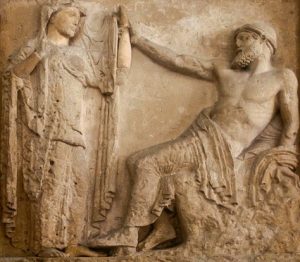
Hera
The last marriage of Zeus was to Hera. Hera gave birth to Heba, Ares and Eileithyia in this marriage. As is known, Ares became the god of war. Furthermore, his union with the titan Atlas’s daughter, Maia on Mount Kellene of Arcadia, produced Hermes, and his union with Semele, the daughter of Cadmos, produced Dionysus. Again, Zeus’s union with Asteria, the daughter of titan Coeus, produced the goddess Hecate.
Zeus’s Lovers
Alcmene
Apart from these marriages, Zeus had secret love affairs as well. He begat many children from these love affairs, which he engaged in unsuspected by his wife Hera. These relationships will now be discussed briefly.
Zeus immensly admired Alcmene, the beautiful and virtuous wife of Amphitryon. While Amphitryon was on his way back from a vistorious battle, Zeus forestalled by disguising himself as him and went to Alcmene’s bed. After a few hours, the real husband came and lay with his wife. Alcmene gave birth to twins named Heracles and İphicles after these intercources. Of these twins, Heracles is assumed to be the son of Zeus. Hera spent her life striving to take revenge from Heracles who was born from this affair. Consequently, Heracles engaged in chivalrous acts and thus mad efor himself a name.
Europa
One day by the sea, Zeus saw beautiful Europa, the daughter of the Phoenician King Agenor, admired
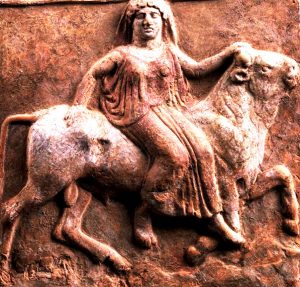
her greatly and began to desire her. But how was he to come together with this beautufil girl without letting his jealous wife Hera know? He immediately thought of an idea; he disguised himself as a bull and went to the lawn on which the girl was playing with her friends. Beautiful Europa saw this cute bull grazing near them and could not help but fondle it. In his most adorable manner, the bull let her caress him and rolled on the ground. Europa suggested to her friends that they ride on the bull and take a stroll. They all accepted this suggestion. Europa mounted and sat on the broad back of the bull. While the others were still setting about to mount on it, the seemingly docile bull began to run all of a sudden and abducted the beautiful girl. Europa’s friends watched in disbliefs as the bull cut across the sea and ran as if travelling on a level plain.
At last, the bull stopped on the island of Crete, put the beautiful girl down underneath the shadow of a large plane tree and appeared as a god again. Under the dark and cool shadow of the tree, he ravished this beautiful girl whom he admired so much. Therefore, King Minos of Crete came into the World from this union.
Io
Zeus admired Io, the daughter of King Inachus of Argos, Io was a nun ar the Temple of Hera in the city of Argos. Zeus seduced Io bu disguising himself as a cloud. Zeus then transformed the girl into a cow to save her from Hera who discovered this relationship. Hera asked Zeus to give the cow to her as a gift, and Zeus could not decline this wish and gave her the cow. Hera actually saw through the the scheme and he put her under the watch of Argus, a hundred-eyed monster. Zeus charged Hermes with rescuing his lover. Hermes went near the monster with his magic wand and pipe. He made the monster sleep by telling it stories and playing his pipe, and killed it afterwards. Hera took the eyes of the monster and placed them into the tails of her sacred pet peacock. Meanwhile, the cow escaped and Hera dispatched a gadfly to follow her. The cow ran and the godfly chased. Thus the cow passed the seas and territories. The first sea that Io passed is known as Ionia, and the first strait she is known as the Bosphorus meaning the ‘passage of cow’. At least, Io managed to stop by the Nile, where Zeus restored her to human form again. There, she gave birth to a child named Epaphus.
Danae
Regardless the jealousies of his wife Hera, Zeus the god of gods continued his love affairs. Next, he fell in love with Danae, the daughter of King Acrisius of Argos. This king had no sons and he had learnt from the oracles that the child to be born from his daughter would overthrow him. Therefore, he enclosed his daughter within a chamber with bronze walls. In the form of a golden rain drop, Zeus seeped through an opening on the ceiling of the chamber and fell over the lap of the girl. Famous Perseus was born from this union.
Leda
One day in his palace in Olympus, Zeus was sitting at a distance place from his wife and thinking something entertainig to do. During this time, he admired Leda the daughter of the king of Aetolia and wife of King Tyndareus of Sparta. While Leda was taking a bath in the lake, Zeus disguised himself as a swan and approached her.
On the same day, Leda united with her husband Tyndareus. Two embryos came into being after this union. Both of the embryos developed into twins.Helen and Castor were assumed to be from Zeus, Clytemestra and Polydeuces were assumed to be from Leda’s husband.
Antiope
Zeus the god of gods, who was a true rascal, was never satiated when it came to beautiful women. Despite his fear, he could not help but cheat on his wife Hera with every woman he admired. One day, he fell in love with Antiope, the beautiful daughter of King Nycteus of Thebes. He disguised himself as a satyr and ravished her. The King soon found out that his daughter was pregnant and he sent his daughter out from his country without knowing whom she concieved from. Zeus begat two children from Antiope named Zethus and Amphion. The children were raised in the mountains by shepherds. Later, they both became rulers in the city of Thebes. Zeus was later enamored of Aegina, the daughter of Asopus the river god. Aegina was Antiope’s sister. Disguised as an eagle and fire, Zeus kidnapped his sweetheart to the island of Oenone and ravished her there. Here, Aegina brought forth Aeacus from Zeus.
Callisto
Another love affair Zeus engaged in was with Callisto, the daughter of the Arcadian king Lycaon.This beautiful girl was Artemis’s friend and had promised her that she would remain immaculate and pure. But she too was tempted and impregnated her into a bear to save her from the wrath of Artemis. Years later, while Arcas was hunting in the woods, his mother came acrosshim in the form of a bear. Arcas was about to trap her unknowingly but Zeus could not wait any longer and hoisted his lover in to the heavens and transformed her into the constellation known as the ‘Great Bear’ and his son into the one known as the ‘Little Bear’.
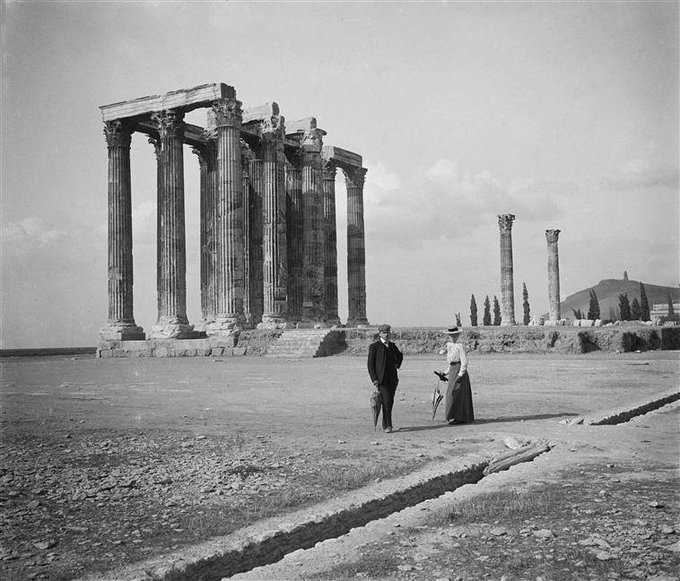
Zeus’s Temples, Attributes and Deciptions
Zeus was illiustrated as a mature man, with his symbolic eagle, holding a thunderbolt in his right hand,
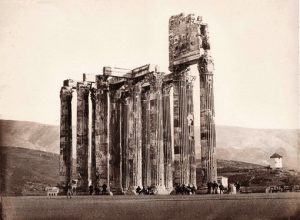
and a wand in his left hand. He was mostly shown while sitting on his throne. The sculptures of him generally decipt him with thick, wavy hair, a broad forehead, an impressive stern-looking face surrounded by a beard. Very rarely is he seen naked except for his earlier deciptions. In his nüde deciptions, he has a cloak leaving his right arm and chest open. His sacred animal was eagle and his sacred plant was the oak. His oracle was in Dodona, which was located in Northern Greece known as the land of oak trees, near the Albanian border. Fort his reason, Zeus sometimes wore a wreath of oak leaves.
Olympic Games and Zeus
The Olympic Games were initially held to honor Zeus. One of the most important temples for Zeus is the temple in the city of Olympia to the West of the Peloponnese. This is where his cult statue was made from gold and ivory, by the famous sculptor Phidias around 435 BC. This Doric temple with 6 X 13 columns dates to the 5th century BC. The Temple of Olympian Zeus (Olympeion) in Athens, which is in the Corinthian style, dates to the 2nd century BC. The temple, where 15 columns remain standing, became identified with the city of Athens. The games and competitions held every year at Olympeion in the name of Zeus turned into the Olympic games of this time. The Temple of Zeus at Akragas, Italy, is the most spectacular one among the Doric temples which remain standing today. The temple measures 53 x 110 m and dates to the 5th century BC.
Anatolian temples of Zeus
Many spectacular temples were erected for Zeus in many antique cities in Anatolia. Among these, most famous and the ones that are still standing are the Temple of Zeus at Uzuncaburc dating to the Hellenistc period, and the Temple of Zeus at Euromos near Milas dating to Roman age, as well as the Temple of Zeus at Aizanoi near Çavdarhisar. The Temple of Zeus at Uzuncaburç has 6 x12 columns and is the oldest known temple in the Corinthian style. The 3rd century BC temple has an extraordinary look with its columns that are intact.The Temple of Zeus at Euromos, which has 6 x11 columns, is in the Corinthian style and is picturesque, appering among olive trees. The Temple of Zeus in Aizanoi from the Roman Period is one of those rare temples that protected its original form to this date. There are 8 columns on the short sides of the marble temple and 15 columns on the long sides ot it, which remain stands today. Apart from these temples that reached to this date intact, there are other temples dedicated to Zeus in many antique cities. In the Caria region of Anatolia, Zeus was worshipped as Zeus Stratios and a spectacular temple was erected for him in Lbaranda. As Phidias, other artists too illustrated Zeus on a Throne. His symbol, an eagle, was sometimes decipted near his throne, sometimes at the tip of his wand and sometimes on top of his hands. The 5th century BC bronze sculpture of him at the National Museum of Athens is one of the most splendid sculptures of him. At a temple on the island of Corfu, Zeus is illustrated on the pediment while fighting against the giants. Zeus reliefs can be seen on the pediments of the temple in Selinus, Bologna and of many others. There are also beautiful samples from the Roman Period decipting Zeus, or Jupiter, as known in Latin. The most beuatiful examples of these are the temple in Capitolium and the temples of Jupiter Stator and Jupiter Victor at the foot of the Palatine Hill. Various sculptures, busts and head statues of Zeus have been obtained and he has been among the inevitable subjects fort he arts of painting and sculpture to this day.The head statue of Zeus from the 2nd century BC at the Bergama (Pergamum) Museum and the one that was found in Troy and is exhibited at the Istanbul Archaeology Museum today, depict him exquisitely.His thick hair and beard, and the poignant look in his eyes would suit those of a chief god. The head statue of Zeus, which was excavated in the antique city of Sagalassos and its exhibited at the Burdur Museum, is one of these typical examples. It is also possible to see many beautiful sculptures of Zeus today at the National Museum of Athens, Louvre Museum, British Museum, among the others including the ones in Turkey such as Istanbul Archaeology Museum, Antalya Museum and the Museum of Anatolian Civilizations in Ankara.

